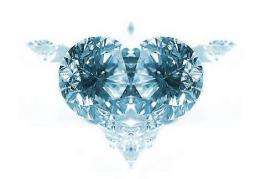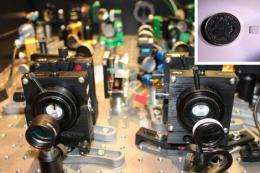Vibration rocks for entangled diamonds

(PhysOrg.com) -- Diamonds are celebrated for their enduring beauty and hardness but they can also be a physicist’s best friend.
In Nature Photonics and Science an international team of scientists report that a strange quantum state called ‘entanglement’ has been achieved in two 3mm-wide diamond crystals, spaced 15cm apart, at room temperature.
‘One of the weird effects well known from atomic-scale systems is the possibility of superposition - the ability of an object to be in two places at once,’ explains Ian Walmsley of Oxford University’s Department of Physics, a member of the team behind the research.
‘We show that you can take two diamonds - not quite everyday objects, but at least simple and recognizable - and put them in such a state: in particular a superposition of a state of one diamond vibrating and the other not, and vice versa.
‘This special type of superposition is called "entangled" and is of a kind that may be used for applications of quantum physics to new technologies, especially in communications and computing.’
Because it is so easily disturbed by its surroundings entanglement can only normally be observed in isolated systems cooled to temperatures close to absolute zero.
But the structure of diamond makes it different: ‘Exciting a vibrational motion in diamond requires a temperature of about 2000 degrees Celsius,’ comments Joshua Nunn of Oxford University’s Department of Physics, also a member of the research team.

‘So at room temperature the vibrations are non-existent. The system behaves in that sense like a very cold cloud of atoms.’
The researchers, from Oxford University, National University of Singapore, and National Research Council of Canada, also sought to exploit another property of diamond: it tends to scatter light in such a way that a photon striking it can be converted to a lower energy photon, with the remaining energy being converted into a vibration.
This vibration or ‘ringing’ in the diamond crystal can be detected using a laser.
‘We sent bursts of laser light through both diamonds,’ Ian tells me. ‘Most of the time the light would travel straight through the crystals but sometimes the light would dump some energy in one of the crystals, setting it ringing, and the light would then emerge with less energy - a lower frequency.’
The light is combined after the crystals so that when a low frequency pulse is detected, it is possible for scientists to know that one diamond is vibrating, but not which one.
‘In fact, the universe doesn't know which diamond is vibrating!’ Joshua explains. ‘The diamonds are entangled, with one vibration shared between them, even though they are separated in space. We could use a similar technique to measure the diamonds and determine that this was the case.’
The fact that entanglement is occurring inside everyday objects is not a surprise, but up until now most people would have thought that it would be impossible to observe: being ‘washed out’ or otherwise disturbed by noise from the environment.
Joshua suggests that their approach might encourage scientists to look for strange quantum effects in places where previously they wouldn’t have expected to be able to spot them.
Whilst any practical applications for the work are a long way off, the Nature Photonics paper does describe how it might be possible to build a diamond ‘quantum memory’ for photonic quantum computing.
Ian comments: ‘Several groups around the world have built different elements of a nanophotonic processor, and a vibrational quantum memory for photons could be incorporated into these.’
Another possibility is explored in a related piece of work using these diamonds that makes use of the quantum character of "nothingness". It exploits this possibility to generate truly random numbers: something that could help to improve the security of electronic communications and transactions.
Provided by Oxford University




















